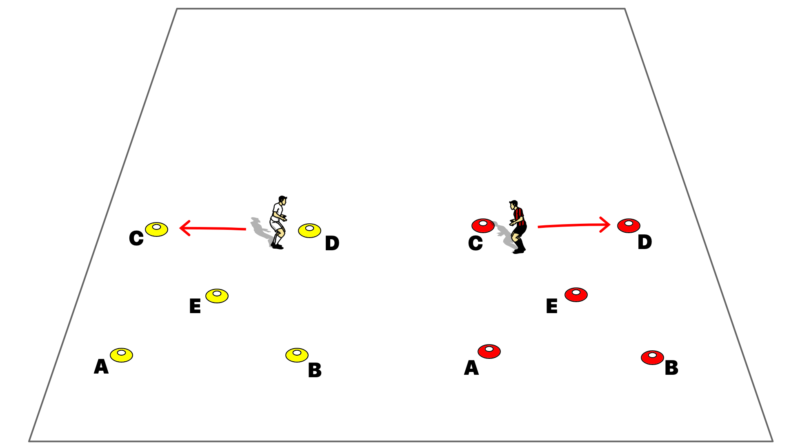The 1v1 reactive agility game is a great opportunity to work with players on perception, decision making, agility, coordination, movement, and creativity. In this article, I describe the activity, its ideas, and provide an example of working with players. The grid is a “box-5” – 5 cones organized a box with a center cone.
The rules of the activity are simple:
- Two players face each other in identical grids
- One players is the “leader”, the other is the “follower” (or “mirror”)
- On a signal, the leader moves through the grid, the mirror must shadow the leader
- The players must face each other (not turn their backs) during the bout
- After a fixed amount of time, the players swap roles
- Points can be assigned for each time the leader beats the follower to a cone
Here is a picture of the activity.

Here is a TacticalPad animation of the activity.
Requiring the players to face each other presents some physical challenges. The players must be able to move laterally and backwards while maintaining balance. The mirror has additional challenges since he/she does not know the direction that the leader will move.
The players are instructed to move from cone-to-cone (versus wandering around in the space).
In the initial version of the activity, the players move without the ball. The videos below are from the UC Premier 2010 (U11) boys team.
In the first video, we see two pairs of players with a leader and mirror.
At first, it is likely that the leader will try to quickly outrun the mirror from one cone to another. We may see either or both players moving with poor technique (crossing over feet, posture too tall, improper weight balance, awkward arm positions). A coaching point that we need to make to the leader is to be deceptive – use body feints, misdirection, etc – to off-balance the opponent. Perception of the opponent and space, analysis of opportunities, decision making, and execution are actions that are directly transferrable to the game – and fit directly into our Principles of Play.
By starting without the ball, we can put the players in motion, create some competition, and then provide coaching points. This is a high intensity activity (when the players are evenly matched). One suggestion is to go with a 2:1 work/rest ratio – 20 secs on, 10 seconds off (Tabatas) or 30 seconds on, 15 seconds off. Rotating players between the grids will keep the players engaged. In summary, working without the ball allows us to focus on the players’ movements, identify key adjustments, and familiarize the players with the patterns and ideas.
The progression of the activity is to add the ball. This will present some additional problems for both players – managing the ball, managing space, and – for the mirror – keeping track of the opponent in order to shadow.
A consequence of requiring the players to face each other is that the players will need to use different foot surfaces (likely the sole) in order to move backwards (linear and diagonal).
In the second group of players, we see the consequence of a mismatch – the leader moving through spaces with the mirror slowly following with a less-than-committed effort.
A possible approach is to discuss with both players at a stoppage the ideas that are working and not working. This allows an opportunity for the stronger player to “coach” the weaker player through his/her description of ideas – rather than the coach simply lecturing the weaker player on fixes. As coaches, we want players to take ownership of their experience. In this example, we may know that the weaker player has the ability to improve performance through some simple changes. Allowing his teammate to share ideas may help motivate risk-taking, resulting in a better outcome.
Some final thoughts
One of the things that I like about this activity is its simplicity – we can describe the rules in less than 30 seconds and get the players immediately involved. This also a “fun” activity for the players – there is competition, creativity, and a winner. Both players have an opportunity to show off.
The challenge is ensuring that the mirror remains engaged with the activity when the leader is more skilled. Allowing both players to share their experiences with each other builds connectedness and can aid in improving motivation.
One other small benefit is that the box-5 can be used as a physical or ball activation space (warm-up) which can then be repurposed into this 1v1 activity.
Developing athletic abilities is important as part of a long-term athletic development (LTAD) program. The 1v1 reactive agility game is an excellent platform for LTAD growth.